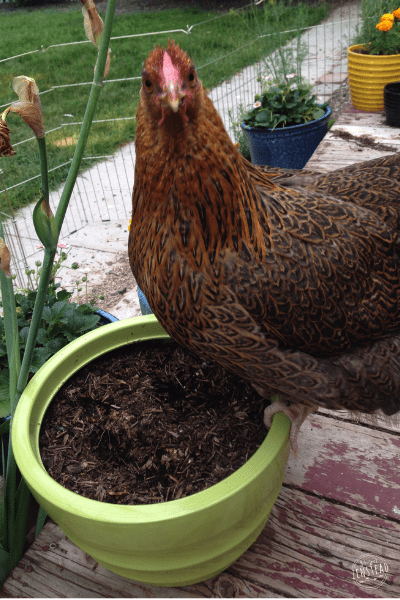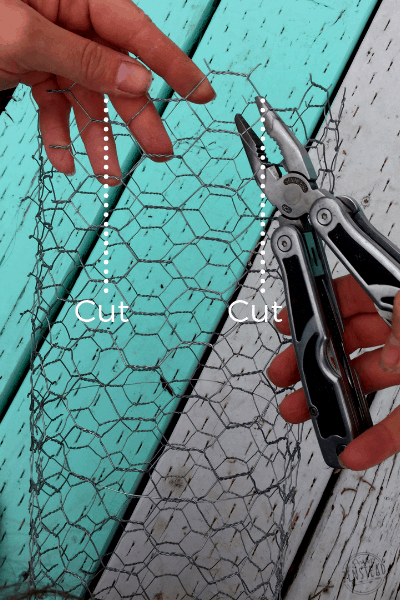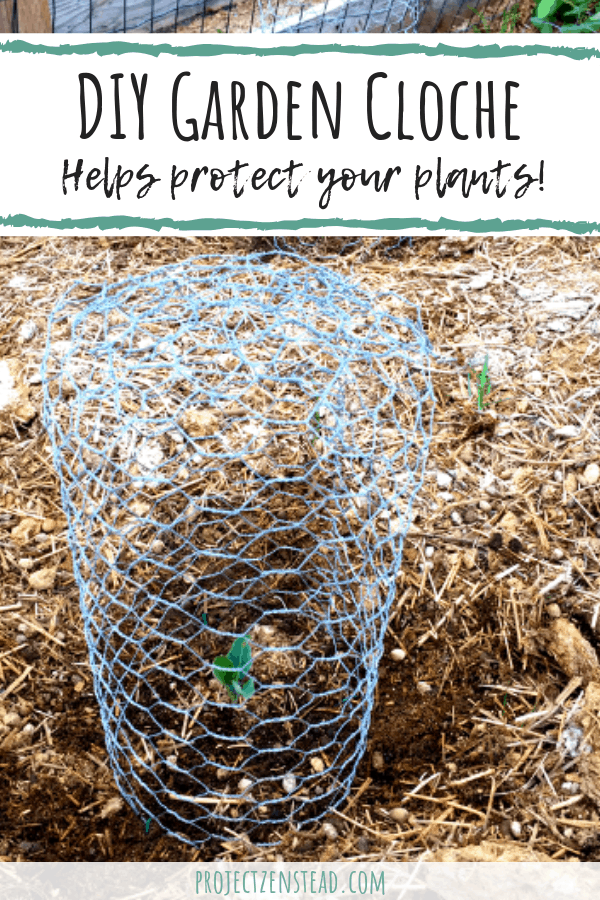You may have a stunning backyard, even with free vary chickens! Discover ways to make a DIY backyard cloche, plus different nice concepts to guard your backyard vegetation and hold each your backyard and your chickens blissful!
Making a backyard that each you and your chickens can take pleasure in tends to be a problem now and again! Spring could be particularly problematic, because of the tiny fragile seedlings which might be popping up.


My free-range velociraptors (err… chickens) rampage my backyard a number of occasions a day, leaving a path of destruction behind!
Throughout most seasons, I welcome their scratching and bug scavenging. However once I plant a bunch of seeds and tender plant begins, these chickens higher depart my backyard alone!
However in fact, they don’t. As a result of they’re chickens. And chickens are sort of jerks. If there’s a tiny child plant that I simply lovingly planted, you may guess that it is going to be the very first thing they destroy!


Sure, I may fence off the backyard or hold them locked of their run, however chickens present lots of advantages round our homestead which is why I take pleasure in letting them free-range.
By the years, we’ve discovered loads about methods to backyard with – or possibly regardless of – chickens! I’ve misplaced a pair vegetation and lots of seeds resulting from their scratching, however I’ve lastly discovered just a few methods to maintain each the chickens and the backyard blissful utilizing wire fencing and backyard cloches.


**This submit comprises affiliate hyperlinks. We might obtain a fee at no expense to you in case you select to join companies utilizing these hyperlinks. See our full affiliate disclosure right here. Thanks for serving to assist this weblog! **
Backyard cloches are coverings that shield vegetation and they’re superb! I exploit them to guard vegetation that I direct seed individually (moderately than in rows), like cabbage and broccoli.
A backyard cloche can be a good way to guard younger vegetation that you simply transplant into your backyard whereas they take root. You can too form them to suit over pots to guard potted flowers and vegetation from chickens and wild birds!


After trying on the worth for commercially-made backyard cloches, I made a decision to assemble my very own to save cash. Fortunately, it’s extremely simple to make a DIY cloche utilizing hen wire. Rolls of hen wire are very inexpensive, so you may make a home made cloche for a fraction of the value of store-bought ones!
To make your personal DIY Backyard Cloche, you’ll need:
Instructions:
Step 1: Begin by rolling out a piece of your hen wire on a flat floor.
Step 2: Minimize the wire utilizing your wire cutters. You may make the cloches as large or small as you want. I made mine by chopping the wire into 2.5 ft x 1.5 ft squares.


Step 3: Kind the wire right into a cylinder form.


Step 4: Overlap the lower edges in order that they’re offset (as seen within the image).


Step 5: Twist the unfastened ends of the lower wire to safe them collectively (as seen beneath).


Step 6: As soon as the wire ends are twisted collectively, resolve which of the open ends would be the high and which would be the backside. I desire to make use of the strong wire facet as the underside.


Step 7: On the highest, lower 4-5 vertical slits into the wire. The slits ought to be about 1/4 to 1/3 of the size of the wire cylinder.


Step 8: Fold the lower slits down in order that they overlap and kind the highest of the cloche. If wanted, you may twist the unfastened ends of the lower wire over the opposite wire in order that the wire flaps keep in place.


Step 9: Place the completed cloche over your plant or seeds and safe it by utilizing 2-3 panorama cloth stakes. Alternatively, you need to use a chunk of heavy gauge wire, folded in half, as a stake.


You possibly can additionally set up backyard fencing. We use a pair rolls of welded wire garden fence (3ft x 50ft) to line our raised backyard beds.
We roll them up within the fall in order that the chickens can scratch and work the compost into the backyard beds over the low season. Then we roll them again out each Spring once we start planting.


We truly lower the fencing in half lengthwise so the fence is 1.5 ft tall (along with the 2-ft raised mattress). In hindsight, I wouldn’t do this once more. It made the wire go a lot farther, which was nice. And on the time, we solely had lovely little bantam chickens who couldn’t leap it.
However over the previous couple of years, we added some athletic full-sized chickens to our flock. And that little fence isn’t stopping them anymore! So the fence does nonetheless assist discourage them considerably, however I want I had left it taller.
One of the simplest ways that I’ve discovered to guard sown seeds and sprouting vegetation is to cowl them with sections of wire fence. This works particularly effectively for seeds/vegetation which might be sown in rows, like radishes and corn. The fencing panels will assist shield them till they’re well-rooted, at which period you may take away the fencing.


This yr, we re-did lots of fencing once we modified the structure of our goat pasture. Because of this, we had a giant roll of salvaged welded wire fencing that was bent and damaged.
I lower the fencing into smaller sections to suit into the backyard areas the place I planted seeds. The sections have been like massive backyard cloches.
I bent the fencing only a bit to present it a curve earlier than I laid it over the backyard soil. The curved form helps discourage the chickens from strolling on it and it additionally offers the vegetation some additional rising house. I plan to save lots of all these panels and reuse them every year in my backyard.


I wish to hear your finest ideas and tips for gardening with free vary chickens! Share with us within the feedback!


Pin this submit for later!
Making a backyard that each you and your chickens can take pleasure in tends to be a problem now and again! Spring could be particularly problematic, because of the tiny fragile seedlings which might be popping up.


My free-range velociraptors (err… chickens) rampage my backyard a number of occasions a day, leaving a path of destruction behind!
Throughout most seasons, I welcome their scratching and bug scavenging. However once I plant a bunch of seeds and tender plant begins, these chickens higher depart my backyard alone!
However in fact, they don’t. As a result of they’re chickens. And chickens are sort of jerks. If there’s a tiny child plant that I simply lovingly planted, you may guess that it is going to be the very first thing they destroy!


Sure, I may fence off the backyard or hold them locked of their run, however chickens present lots of advantages round our homestead which is why I take pleasure in letting them free-range.
By the years, we’ve discovered loads about methods to backyard with – or possibly regardless of – chickens! I’ve misplaced a pair vegetation and lots of seeds resulting from their scratching, however I’ve lastly discovered just a few methods to maintain each the chickens and the backyard blissful utilizing wire fencing and backyard cloches.


**This submit comprises affiliate hyperlinks. We might obtain a fee at no expense to you in case you select to join companies utilizing these hyperlinks. See our full affiliate disclosure right here. Thanks for serving to assist this weblog! **
What Does a Backyard Cloche Do?
Backyard cloches are coverings that shield vegetation and they’re superb! I exploit them to guard vegetation that I direct seed individually (moderately than in rows), like cabbage and broccoli.
A backyard cloche can be a good way to guard younger vegetation that you simply transplant into your backyard whereas they take root. You can too form them to suit over pots to guard potted flowers and vegetation from chickens and wild birds!


After trying on the worth for commercially-made backyard cloches, I made a decision to assemble my very own to save cash. Fortunately, it’s extremely simple to make a DIY cloche utilizing hen wire. Rolls of hen wire are very inexpensive, so you may make a home made cloche for a fraction of the value of store-bought ones!
How Do You Make a Backyard Cloche?
To make your personal DIY Backyard Cloche, you’ll need:
Instructions:
Step 1: Begin by rolling out a piece of your hen wire on a flat floor.
Step 2: Minimize the wire utilizing your wire cutters. You may make the cloches as large or small as you want. I made mine by chopping the wire into 2.5 ft x 1.5 ft squares.


Step 3: Kind the wire right into a cylinder form.


Step 4: Overlap the lower edges in order that they’re offset (as seen within the image).


Step 5: Twist the unfastened ends of the lower wire to safe them collectively (as seen beneath).


Step 6: As soon as the wire ends are twisted collectively, resolve which of the open ends would be the high and which would be the backside. I desire to make use of the strong wire facet as the underside.


Step 7: On the highest, lower 4-5 vertical slits into the wire. The slits ought to be about 1/4 to 1/3 of the size of the wire cylinder.


Step 8: Fold the lower slits down in order that they overlap and kind the highest of the cloche. If wanted, you may twist the unfastened ends of the lower wire over the opposite wire in order that the wire flaps keep in place.


Step 9: Place the completed cloche over your plant or seeds and safe it by utilizing 2-3 panorama cloth stakes. Alternatively, you need to use a chunk of heavy gauge wire, folded in half, as a stake.


Extra Methods to Shield Your Backyard from Chickens
You possibly can additionally set up backyard fencing. We use a pair rolls of welded wire garden fence (3ft x 50ft) to line our raised backyard beds.
We roll them up within the fall in order that the chickens can scratch and work the compost into the backyard beds over the low season. Then we roll them again out each Spring once we start planting.


We truly lower the fencing in half lengthwise so the fence is 1.5 ft tall (along with the 2-ft raised mattress). In hindsight, I wouldn’t do this once more. It made the wire go a lot farther, which was nice. And on the time, we solely had lovely little bantam chickens who couldn’t leap it.
However over the previous couple of years, we added some athletic full-sized chickens to our flock. And that little fence isn’t stopping them anymore! So the fence does nonetheless assist discourage them considerably, however I want I had left it taller.
DIY Backyard Fence Concepts
One of the simplest ways that I’ve discovered to guard sown seeds and sprouting vegetation is to cowl them with sections of wire fence. This works particularly effectively for seeds/vegetation which might be sown in rows, like radishes and corn. The fencing panels will assist shield them till they’re well-rooted, at which period you may take away the fencing.


This yr, we re-did lots of fencing once we modified the structure of our goat pasture. Because of this, we had a giant roll of salvaged welded wire fencing that was bent and damaged.
I lower the fencing into smaller sections to suit into the backyard areas the place I planted seeds. The sections have been like massive backyard cloches.
I bent the fencing only a bit to present it a curve earlier than I laid it over the backyard soil. The curved form helps discourage the chickens from strolling on it and it additionally offers the vegetation some additional rising house. I plan to save lots of all these panels and reuse them every year in my backyard.


I wish to hear your finest ideas and tips for gardening with free vary chickens! Share with us within the feedback!


Pin this submit for later!


Kaylee is the Founding father of Rootedrevival.com. She has arrange and run two homesteads, a one-acre in Idaho, and her present two-acre dream homestead within the Pacific North West. Her {qualifications} embrace a Permaculture Design Certification from Oregon State College, and he or she is a Gardenary Licensed Backyard Coach. Kaylee presently produces at the very least 80% of her personal meals. She contributes to our website via articles, coaching and training to our shoppers. You may learn extra about her at rootedrevival.com/kaylee-vaughn
View all posts
